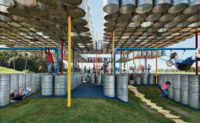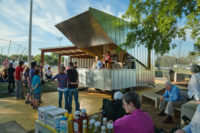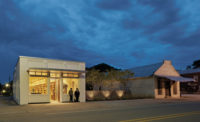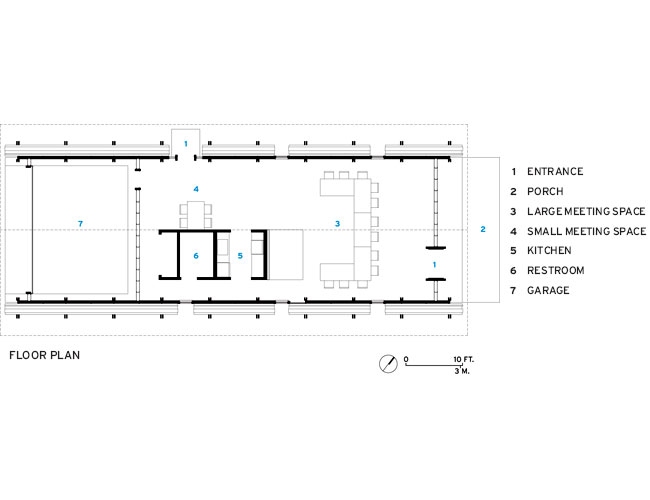Lions Park Scout Hut by Rural Studio
Greensboro, Alabama








Architects & Firms
Like so many Boy Scout troops, which meet in church basements or their Scoutmaster's living room, Greensboro, Alabama's Scout Troop 13 and Cub Pack 13 had no place to call home. For years, they had been gathering in the extension office of the Alabama Fish Farming Center, which provides technical advice on catfish production and sits on the edge of Greensboro's 40-acre Lions Park. Over time, the Scouts had labored to clean the park, “bushhogging” (clearing undergrowth) and maintaining trails. In a way, they had become its unofficial stewards. They were in good company: Auburn University's Rural Studio design-build program had been working there on a multiphase restoration since 2006, creating playing fields, restrooms, landscaping, a playground, and a skate park. “From day one, we knew there was a need to help the Scouts with a headquarters that could give them an identity,” says Rural Studio director Andrew Freear. “But we were struggling to understand where to put another object building—we did not want it floating in the park.”
“From the get-go, we knew we wanted a wood building,” says Elizabeth Whitlock, one of the four-person student team. After studying the Scout-hut archetype, the students set out to find a new way to use timber that would still achieve the desired simplicity. For years, the studio had been experimenting with thinnings—small-diameter trees that are harvested to prevent them from competing with larger, more valuable ones. Seen as refuse, thinnings are chipped or pulped, used as fence posts or firewood. They are cheap, but dimensionally unstable. The more you manipulate the wood, the more you weaken it and add cost, notes Freear. “We tried to touch the thinnings as little as possible, using them as dead weight.”
Sandwiched 2-by-6 rough-cut Southern yellow pine bents form the trusses. Inside, these elements support the roof; outside, they cradle the thinnings, which the team stripped of their bark and treated with copper naphthenate to prevent decay and insect infestation. (All of the wood was obtained from within 50 miles of the site.) The logs are held in place by their neighbors. While Whitlock describes the site and slab work as the most challenging part of the job, lifting the logs was the most physically grueling. “It just required brute strength,” she says. In addition to protecting the hut from the elements, the heavy walls act as ballast— or, as Freear says, “saddlebags”—adding tension to the trusses and grounding the building in potential hurricane-force 110-mile-per-hour winds, as mandated by code. Atop slender steel footings set into the slab, the unique wall configuration lifts its skirts 18 inches to expose a ground-level polycarbonate ribbon window, which runs along the building's long sides, admitting a soft light across the polished concrete floor inside. The team did not want horizontal connections for the end walls, so used heavy-gauge 2-by-6 steel studs, which are visible through honeycomb polycarbonate.
In keeping with the rustic aesthetic, the team clad the interior in 1-inch rough-finish Southern yellow pine. A woodburning stove is the sole source of heat and, in summer, two extractor fans and large rotating ceiling fans facilitate airflow.
As with all Rural Studio projects, the team was backed by a number of consultants, among them Chicago-based structural engineer Joe Farruggia, who has worked with the studio for 10 years. Farruggia guided the team over the phone or on-site. “They would resolve these structural details and develop them into these beautiful pieces,” he says. “That's where the elegance of the structure comes from. Once they decide what it should look like, I just run the numbers.”
Design and construction took two and a half years. By the ribbon cutting last April, the students had long since graduated. But, true to Rural Studio tradition, they had stayed on as super-thesis students—affectionately known as “leftovers”—to see the job through, achieving closure for their hands-on education and leaving Greensboro's Scouts with a home of their own.
PeopleClient: Greg Whitis & Adam Benefield – Boy Scouts and Cub Scouts of Greensboro, Alabama Owner: Lions Club Architect: Personnel in architect's firm who should receive special credit: Faculty team: Director Andrew Freear, Instructors: Elena Barthel, Xavier Vendrell, Dick Hudgens AIA , Steve Long, Mackenzie Stagg, Cameron Acheson, John Marusich, Johnny Parker Architect of record: David Hinson Architect, FAIA, Auburn, Alabama Engineers: Consultant(s): Lighting: Sarah Fisher - Atelier Ten, New Haven, Connecticut Acoustical: Gaines Hall FAIA University of Illinois at Urbana-Champaign Environmental Consultants: Claire Maxfield - Atelier Ten San Francisco, California and Paul Stoller - Atelier Ten Sydney, Australia Photographer(s): Size: 2,000 square feet Completion date: May 2014 |
|
ProductsStructural system Manufacturer of any structural components unique to this project: Walls - 2x4, 2x6 Southern Yellow Pine Westervelt Lumber Company, Moundville, Alabama www.westervelt.com/ 2x4, 2x6 Southern Yellow Pine Wilcutt Block Supply, Tuscaloosa, Alabama Metal: Turnipseed International, Birmingham, Alabama Metal Studs: Southeastern Stud and Components, Montgomery, Alabama Fabrication: Superior Metal Works, Newbern, Alabama and Stillwater Machine, Newbern, Alabama Exterior cladding -McShan Lumber Company, McShan, Alabama -USDA National Forest Service, Oakmulgee District, Centerville, Alabama Moisture barrier: tar paper Other cladding unique to this project: 16mm Polycarbonate sheets – Calsak Plastics, Atlanta, Georgia www.calsakplastics.com/ Roofing Windows Glazing Doors Wood doors: Hardware Closers: Kawneer North America, Norcross, Georgia Pulls:Kawneer North America, Norcross, Georgia Interior finishes Wall coverings:1x12 true dimension rough cut Southern Yellow Pine boards, McShan Lumber, McShan, Alabama Paneling: Solid surfacing:Finished Concrete Slab, Consultant - Tim Wenger, Newbern, Alabama Lighting Up & Down lights: Utilitech 2 Head CFL, Bronze Switch Controlled - Lowe’s Plumbing Sinks: Project Source– Lowe’s Other unique products that contribute to sustainability: Vogelzang Ponderosa Wood Stove Knape & Associates, Red 15 centrifugal roof exhauster, Houston, Texas ***All dimensional lumber, plywood, rough cut pine 2x6s and 2x4s for the trusses, and 1x12 pine cladding is material from a SFI certified and sustainable forest. |










